O2 Carrier Myoglobin Also Exhibits β-Lactamase Activity That Is Regulated by the Heme Coordination State
Abstract
1. Introduction
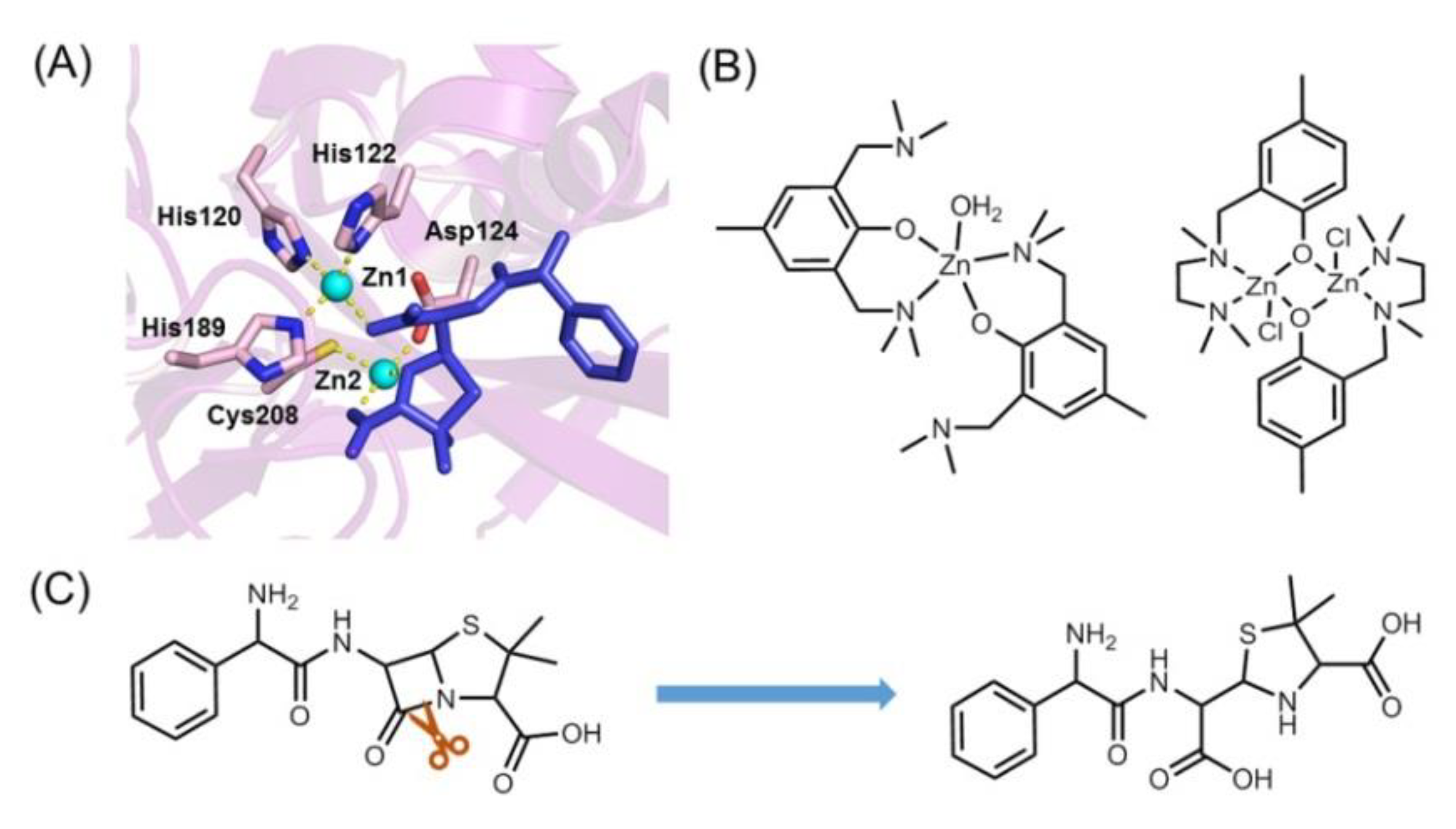
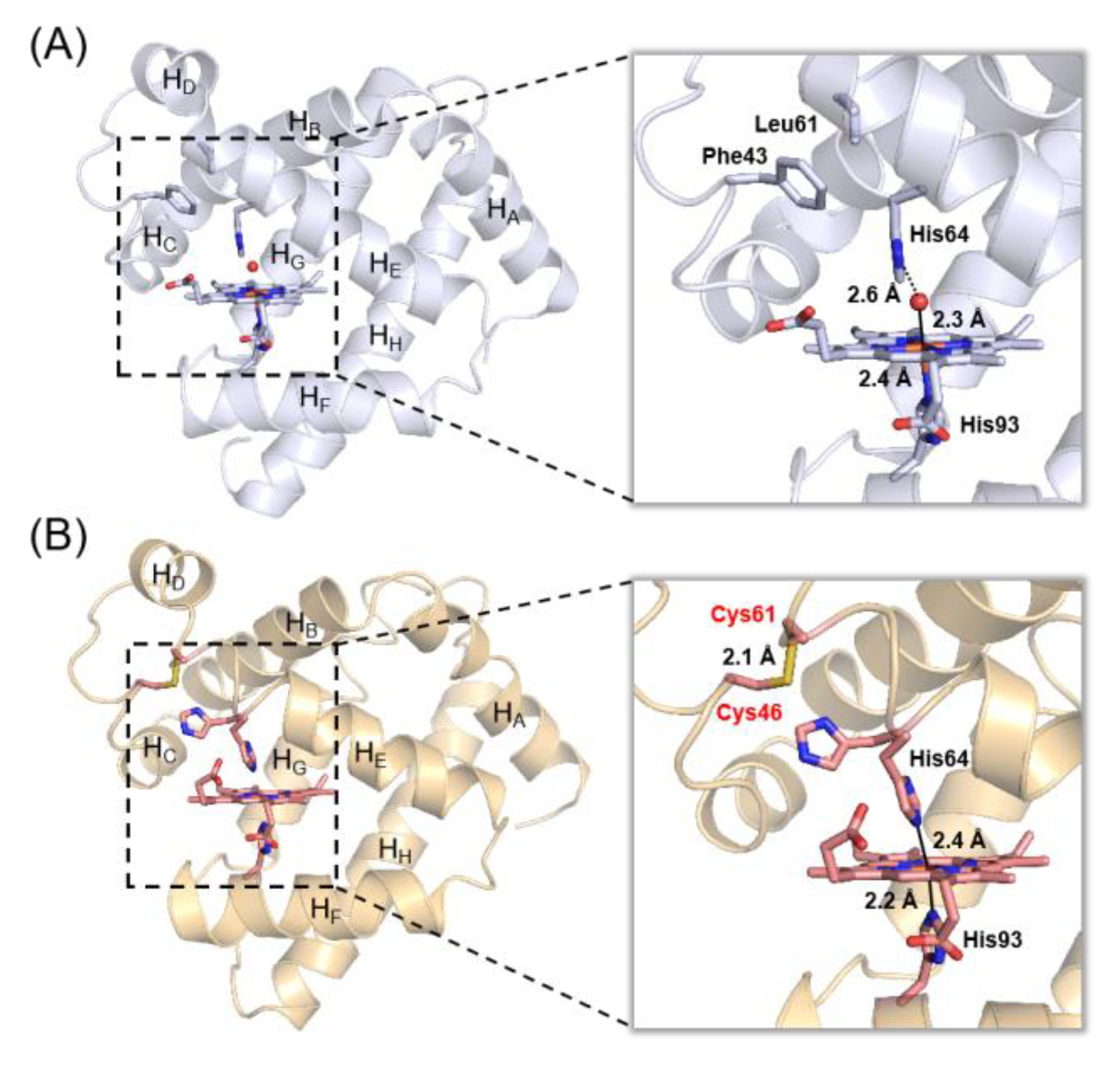
2. Results and Discussion
2.1. Hydrolysis of AMP Catalyzed by WT Mb
2.2. Standard Curve and Self-Hydrolysis of AMP
2.3. The β-Lactamase Activity of Mbs and Effects of Im Binding
2.4. Effects of the Hydrolysis Product of AMP on the Growth of E. coli Cells
3. Conclusions
4. Materials and Methods
4.1. Protein Preparation
4.2. Mass Spectrometry Studies
4.3. High-Performance Liquid Chromatography (HPLC) Studies
4.4. Growth of E. coli Cells under the Hydrolysis of AMP
Author Contributions
Funding
Institutional Review Board Statement
Informed Consent Statement
Data Availability Statement
Conflicts of Interest
References
- Cha, J.M.; Yang, S.; Carlson, K.H. Trace determination of beta-lactam antibiotics in surface water and urban wastewater using liquid chromatography combined with electrospray tandem mass spectrometry. J. Chromatogr. A 2006, 1115, 46–57. [Google Scholar] [CrossRef] [PubMed]
- Gaynes, R. The Discovery of Penicillin—New Insights after More than 75 Years of Clinical Use. Emerg. Infect. Dis. 2017, 23, 849–853. [Google Scholar] [CrossRef]
- Pruden, A.; Pei, R.; Storteboom, H.; Carlson, K.H. Antibiotic resistance genes as emerging contaminants: Studies in northern Colorado. Environ. Sci. Technol. 2006, 40, 7445–7450. [Google Scholar] [CrossRef] [PubMed]
- Reichert, G.; Hilgert, S.; Fuchs, S.; Azevedo, J.C.R. Emerging contaminants and antibiotic resistance in the different environmental matrices of Latin America. Environ. Pollut. 2019, 255, 113140. [Google Scholar] [CrossRef] [PubMed]
- Zhao, Q.; Guo, W.; Luo, H.; Xing, C.; Wang, H.; Liu, B.; Si, Q.; Ren, N. Deciphering the transfers of antibiotic resistance genes under antibiotic exposure conditions: Driven by functional modules and bacterial community. Water Res. 2021, 205, 117672. [Google Scholar] [CrossRef]
- Kummerer, K. Antibiotics in the aquatic environment—A review—Part I. Chemosphere 2009, 75, 417–434. [Google Scholar] [CrossRef] [PubMed]
- Drawz, S.M.; Bonomo, R.A. Three decades of beta-lactamase inhibitors. Clin. Microbiol. Rev. 2010, 23, 160–201. [Google Scholar] [CrossRef] [PubMed]
- Manzetti, S.; Ghisi, R. The environmental release and fate of antibiotics. Mar. Pollut. Bull. 2014, 79, 7–15. [Google Scholar] [CrossRef] [PubMed]
- Huerta, B.; Marti, E.; Gros, M.; Lopez, P.; Pompeo, M.; Armengol, J.; Barcelo, D.; Balcazar, J.L.; Rodriguez-Mozaz, S.; Marce, R. Exploring the links between antibiotic occurrence, antibiotic resistance, and bacterial communities in water supply reservoirs. Sci. Total Environ. 2013, 456–457, 161–170. [Google Scholar] [CrossRef] [PubMed]
- Chen, J.; Sun, P.; Zhang, Y.; Huang, C.H. Multiple Roles of Cu(II) in Catalyzing Hydrolysis and Oxidation of beta-Lactam Antibiotics. Environ. Sci Technol. 2016, 50, 12156–12165. [Google Scholar] [CrossRef] [PubMed]
- Chen, J.; Sun, P.; Zhou, X.; Zhang, Y.; Huang, C.H. Cu(II)-catalyzed transformation of benzylpenicillin revisited: The overlooked oxidation. Environ. Sci Technol. 2015, 49, 4218–4225. [Google Scholar] [CrossRef] [PubMed]
- Chen, J.; Wang, Y.; Qian, Y.; Huang, T. Fe(III)-promoted transformation of beta-lactam antibiotics: Hydrolysis vs oxidation. J. Hazard. Mater. 2017, 335, 117–124. [Google Scholar] [CrossRef] [PubMed]
- Balakrishnan, R.M.; Ilango, I.; Gamana, G.; Bui, X.-T.; Pugazhendhi, A. Cobalt ferrite nanoparticles and peroxymonosulfate system for the removal of ampicillin from aqueous solution. J. Water Process Eng. 2021, 40, 101823. [Google Scholar] [CrossRef]
- Timm, A.; Borowska, E.; Majewsky, M.; Merel, S.; Zwiener, C.; Brase, S.; Horn, H. Photolysis of four beta-lactam antibiotics under simulated environmental conditions: Degradation, transformation products and antibacterial activity. Sci. Total Environ. 2019, 651, 1605–1612. [Google Scholar] [CrossRef]
- Abraham, E.P.; Chain, E. An enzyme from bacteria able to destroy penicillin. Nature 1940, 146, 837. [Google Scholar] [CrossRef]
- Ambler, R. The structure of ß-lactamases Phil. Trans. R. Soc. Lond. 1980, 289, 321–331. [Google Scholar]
- Bush, K. Proliferation and significance of clinically relevant beta-lactamases. Ann. N. Y. Acad. Sci. 2013, 1277, 84–90. [Google Scholar] [CrossRef] [PubMed]
- Raczynska, J.E.; Imiolczyk, B.; Komorowska, M.; Sliwiak, J.; Czyrko-Horczak, J.; Brzezinski, K.; Jaskolski, M. Flexible loops of New Delhi metallo-beta-lactamase modulate its activity towards different substrates. Int. J. Biol. Macromol. 2020, 158, 104–115. [Google Scholar] [CrossRef]
- Daumann, L.J.; Schenk, G.; Gahan, L.R. Metallo-β-lactamases and Their Biomimetic Complexes. Eur. J. Inorg. Chem. 2014, 2014, 2869–2885. [Google Scholar] [CrossRef]
- Song, W.J.; Tezcan, F.A. A designed supramolecular protein assembly with in vivo enzymatic activity. Science 2014, 346, 1525–1528. [Google Scholar] [CrossRef]
- Zhou, Q.; Xiao, Q.; Zhang, Y.; Wang, X.; Xiao, Y.; Shi, D. Pig liver esterases PLE1 and PLE6: Heterologous expression, hydrolysis of common antibiotics and pharmacological consequences. Sci. Rep. 2019, 9, 15564. [Google Scholar] [CrossRef] [PubMed]
- Tamilselvi, A.; Nethaji, M.; Mugesh, G. Antibiotic resistance: Mono- and dinuclear zinc complexes as metallo-beta-lactamase mimics. Chemistry 2006, 12, 7797–7806. [Google Scholar] [CrossRef] [PubMed]
- Hirota, S. Oligomerization of cytochrome c, myoglobin, and related heme proteins by 3D domain swapping. J. Inorg. Biochem. 2019, 194, 170–179. [Google Scholar] [CrossRef] [PubMed]
- Lin, Y.W. Structure and function of heme proteins regulated by diverse post-translational modifications. Arch. Biochem. Biophys. 2018, 641, 1–30. [Google Scholar] [CrossRef] [PubMed]
- Poulos, T.L. Heme enzyme structure and function. Chem. Rev. 2014, 114, 3919–3962. [Google Scholar] [CrossRef]
- Yeung, N.; Lu, Y. One heme, diverse functions: Using biosynthetic myoglobin models to gain insights into heme-copper oxidases and nitric oxide reductases. Chem. Biodivers. 2008, 5, 1437–1454. [Google Scholar] [CrossRef] [PubMed]
- Alvarez-Paggi, D.; Hannibal, L.; Castro, M.A.; Oviedo-Rouco, S.; Demicheli, V.; Tortora, V.; Tomasina, F.; Radi, R.; Murgida, D.H. Multifunctional Cytochrome c: Learning New Tricks from an Old Dog. Chem. Rev. 2017, 117, 13382–13460. [Google Scholar] [CrossRef]
- Feng, Y.; Liu, X.C.; Li, L.; Gao, S.Q.; Wen, G.B.; Lin, Y.W. Naturally Occurring I81N Mutation in Human Cytochrome c Regulates Both Inherent Peroxidase Activity and Interactions with Neuroglobin. ACS Omega 2022, 7, 11510–11518. [Google Scholar] [CrossRef] [PubMed]
- Zhang, P.; Xu, J.; Wang, X.-J.; He, B.; Gao, S.-Q.; Lin, Y.-W. The Third Generation of Artificial Dye-Decolorizing Peroxidase Rationally Designed in Myoglobin. ACS Catal. 2019, 9, 7888–7893. [Google Scholar] [CrossRef]
- Zhang, P.; Yuan, H.; Xu, J.; Wang, X.-J.; Gao, S.-Q.; Tan, X.; Lin, Y.-W. A Catalytic Binding Site Together with a Distal Tyr in Myoglobin Affords Catalytic Efficiencies Similar to Natural Peroxidases. ACS Catal. 2019, 10, 891–896. [Google Scholar] [CrossRef]
- Yin, L.L.; Yuan, H.; Liu, C.; He, B.; Gao, S.-Q.; Wen, G.-B.; Tan, X.; Lin, Y.-W. A Rationally Designed Myoglobin Exhibits a Catalytic Dehalogenation Efficiency More than 1000-Fold That of a Native Dehaloperoxidase. ACS Catal. 2018, 8, 9619–9624. [Google Scholar] [CrossRef]
- Yeung, N.; Lin, Y.W.; Gao, Y.G.; Zhao, X.; Russell, B.S.; Lei, L.; Miner, K.D.; Robinson, H.; Lu, Y. Rational design of a structural and functional nitric oxide reductase. Nature 2009, 462, 1079–1082. [Google Scholar] [CrossRef]
- Lin, Y.W.; Yeung, N.; Gao, Y.G.; Miner, K.D.; Tian, S.; Robinson, H.; Lu, Y. Roles of glutamates and metal ions in a rationally designed nitric oxide reductase based on myoglobin. Proc. Natl. Acad. Sci. USA 2010, 107, 8581–8586. [Google Scholar] [CrossRef] [PubMed]
- Wu, L.B.; Yuan, H.; Gao, S.Q.; You, Y.; Nie, C.-M.; Wen, G.-B.; Lin, Y.-W.; Tan, X. Regulating the nitrite reductase activity of myoglobin by redesigning the heme active center. Nitric Oxide 2016, 57, 21–29. [Google Scholar] [CrossRef]
- Bhagi-Damodaran, A.; Michael, M.A.; Zhu, Q.; Reed, J.; Sandoval, B.A.; Mirts, E.N.; Chakraborty, S.; Moenne-Loccoz, P.; Zhang, Y.; Lu, Y. Why copper is preferred over iron for oxygen activation and reduction in haem-copper oxidases. Nat. Chem. 2017, 9, 257–263. [Google Scholar] [CrossRef] [PubMed]
- Lin, Y.; Wang, J.; Lu, Y. Functional tuning and expanding of myoglobin by rational protein design. Sci. China Chem. 2014, 57, 346–355. [Google Scholar] [CrossRef]
- Bordeaux, M.; Tyagi, V.; Fasan, R. Highly diastereoselective and enantioselective olefin cyclopropanation using engineered myoglobin-based catalysts. Angew. Chem. Int. Ed. Engl. 2015, 54, 1744–1748. [Google Scholar] [CrossRef]
- Sreenilayam, G.; Fasan, R. Myoglobin-catalyzed intermolecular carbene N-H insertion with arylamine substrates. Chem. Commun. 2015, 51, 1532–1534. [Google Scholar] [CrossRef]
- Dydio, P.; Key, H.M.; Nazarenko, A.; Rha, J.Y.; Seyedkazemi, V.; Clark, D.S.; Hartwig, J.F. An artificial metalloenzyme with the kinetics of native enzymes. Science 2016, 354, 102–106. [Google Scholar] [CrossRef]
- Yu, Y.; Hu, C.; Xia, L.; Wang, J. Artificial Metalloenzyme Design with Unnatural Amino Acids and Non-Native Cofactors. ACS Catal. 2018, 8, 1851–1863. [Google Scholar] [CrossRef]
- Oohora, K.; Hayashi, T. Myoglobins engineered with artificial cofactors serve as artificial metalloenzymes and models of natural enzymes. Dalton Trans. 2021, 50, 1940–1949. [Google Scholar] [CrossRef] [PubMed]
- Bhattacharya, S.; Margheritis, E.G.; Takahashi, K.; Kulesha, A.; D’Souza, A.; Kim, I.; Yoon, J.H.; Tame, J.R.H.; Volkov, A.N.; Makhlynets, O.V.; et al. NMR-guided directed evolution. Nature 2022, 610, 389–393. [Google Scholar] [CrossRef] [PubMed]
- Springer, B.A.; Sligar, S.G. High-level expression of sperm whale myoglobin in Escherichia coli. Proc. Natl. Acad. Sci. USA 1987, 84, 8961–8965. [Google Scholar] [CrossRef] [PubMed]
- Sun, L.J.; Yuan, H.; Yu, L.; Gao, S.-Q.; Wen, G.-B.; Tan, X.; Lin, Y.-W. Structural and functional regulations by a disulfide bond designed in myoglobin like human neuroglobin. Chem. Commun. 2022, 58, 5885–5888. [Google Scholar] [CrossRef]
- Yan, D.J.; Yuan, H.; Li, W.; Xiang, Y.; He, B.; Nie, C.-M.; Wen, G.B.; Lin, Y.-W.; Tan, X. How a novel tyrosine-heme cross-link fine-tunes the structure and functions of heme proteins: A direct comparitive study of L29H/F43Y myoglobin. Dalton Trans. 2015, 44, 18815–18822. [Google Scholar] [CrossRef]
- Zeng, J.; Zhao, Y.; Li, W.; Tan, X.; Wen, G.-B.; Lin, Y.-W. Hydrogen-bonding network in heme active site regulates the hydrolysis activity of myoglobin. J. Mol. Catal. B Enzym. 2015, 111, 9–15. [Google Scholar] [CrossRef]
- Yong, D.; Toleman, M.A.; Giske, C.G.; Cho, H.S.; Sundman, K.; Lee, K.; Walsh, T.R. Characterization of a new metallo-beta-lactamase gene, bla(NDM-1), and a novel erythromycin esterase gene carried on a unique genetic structure in Klebsiella pneumoniae sequence type 14 from India. Antimicrob. Agents Chemother. 2009, 53, 5046–5054. [Google Scholar] [CrossRef]
- Nagakubo, T.; Kumano, T.; Hashimoto, Y.; Kobayashi, M. Hemoglobin catalyzes CoA degradation and thiol addition to flavonoids. Sci. Rep. 2018, 8, 1282. [Google Scholar] [CrossRef]
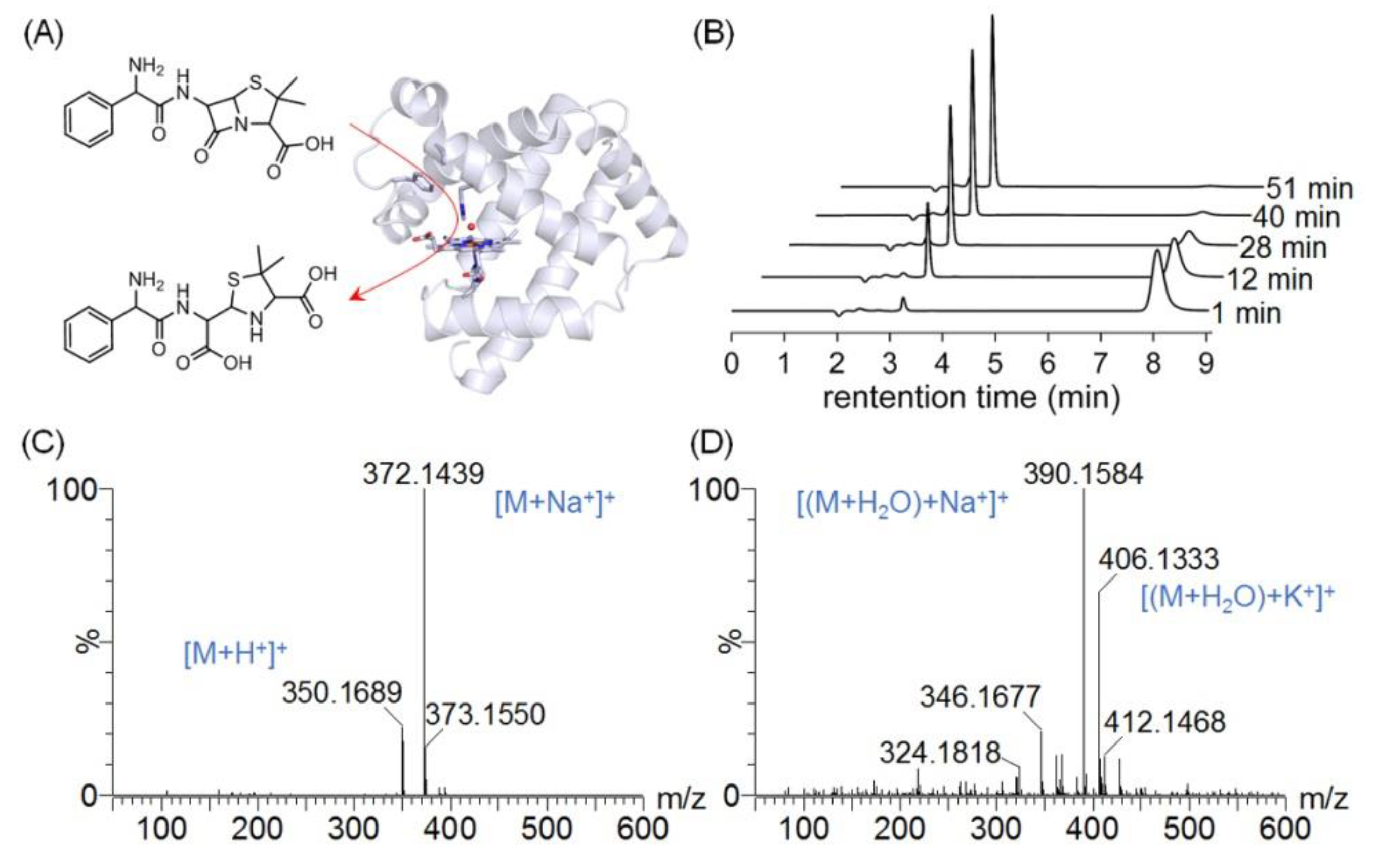
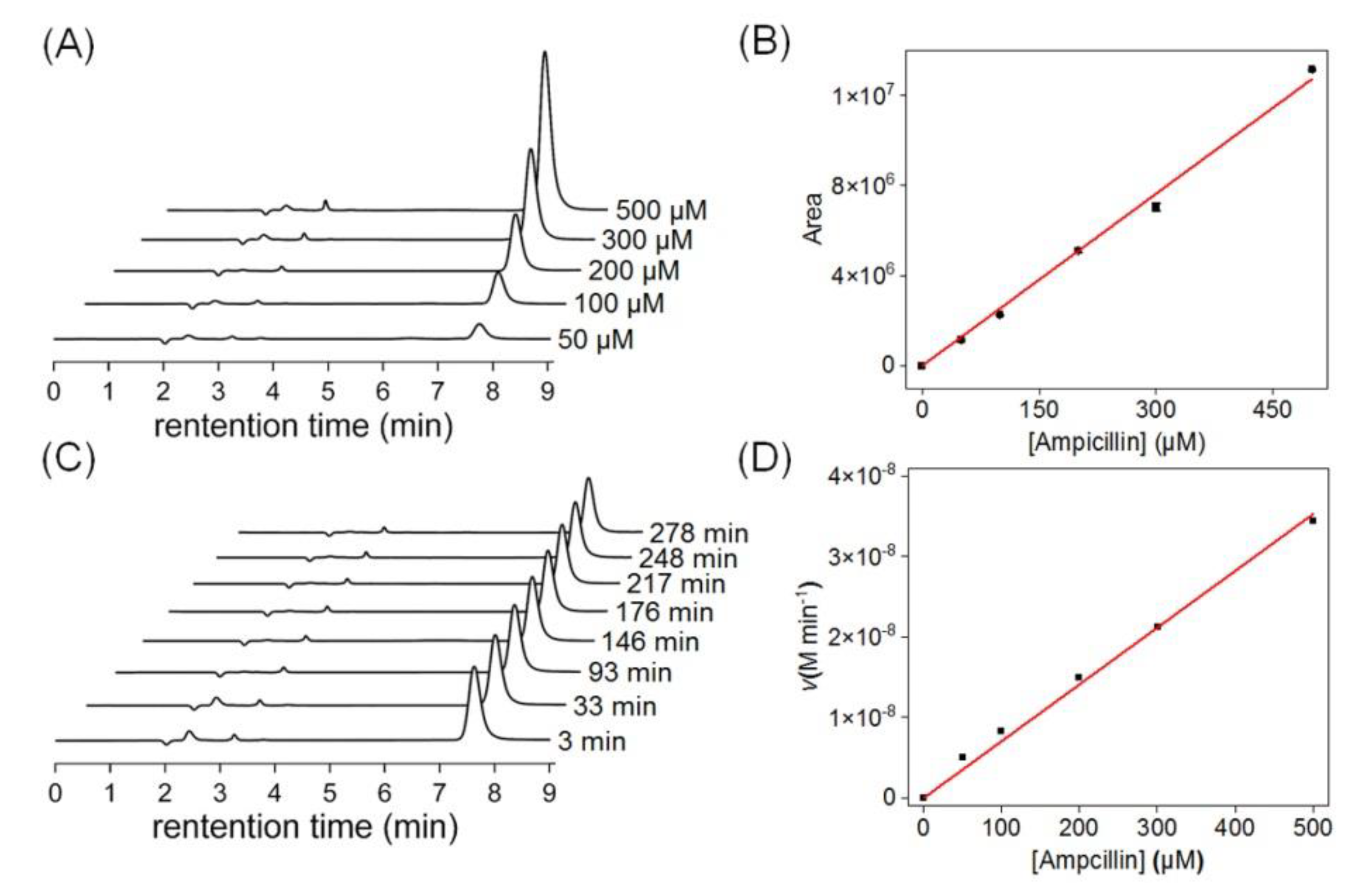
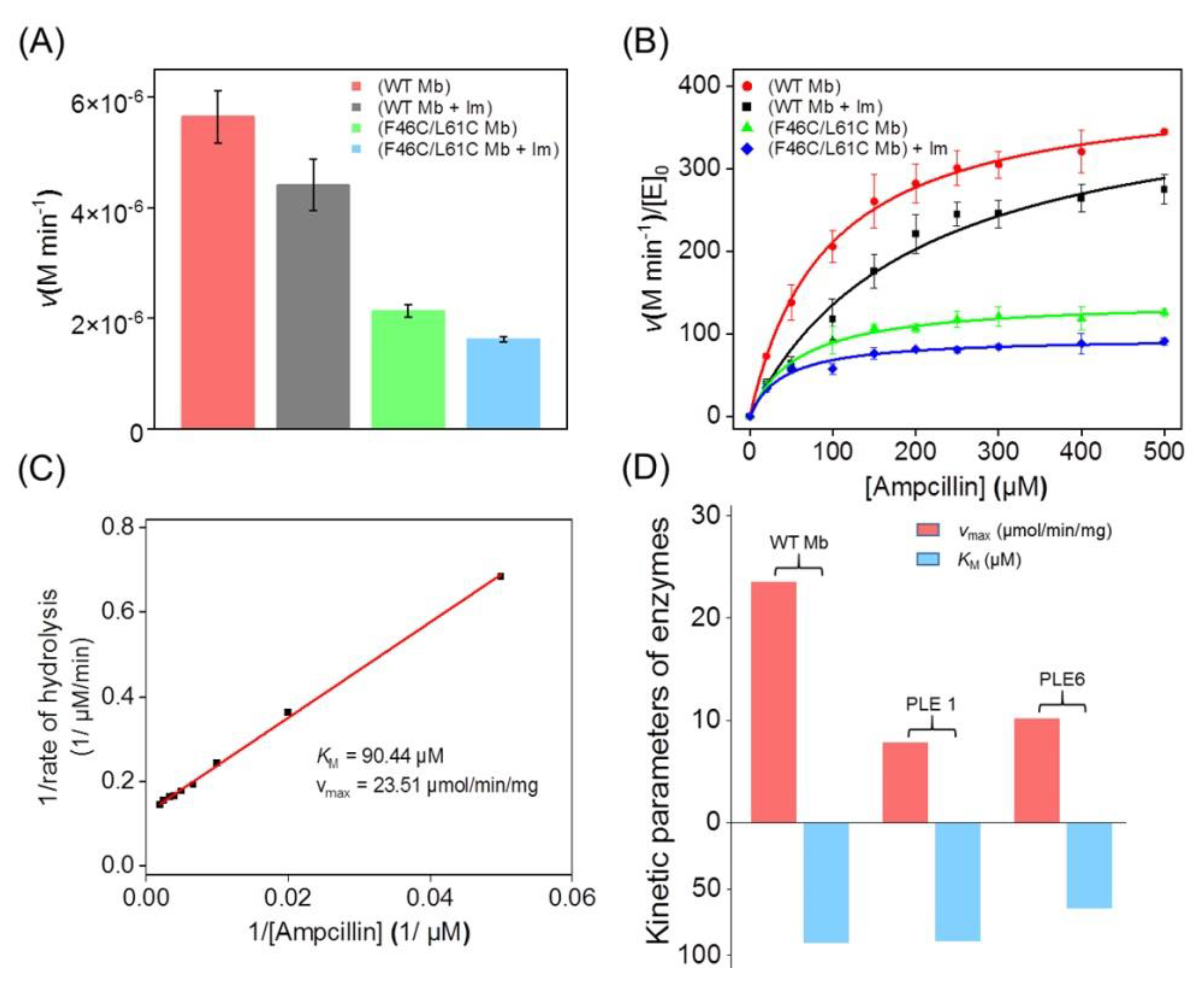
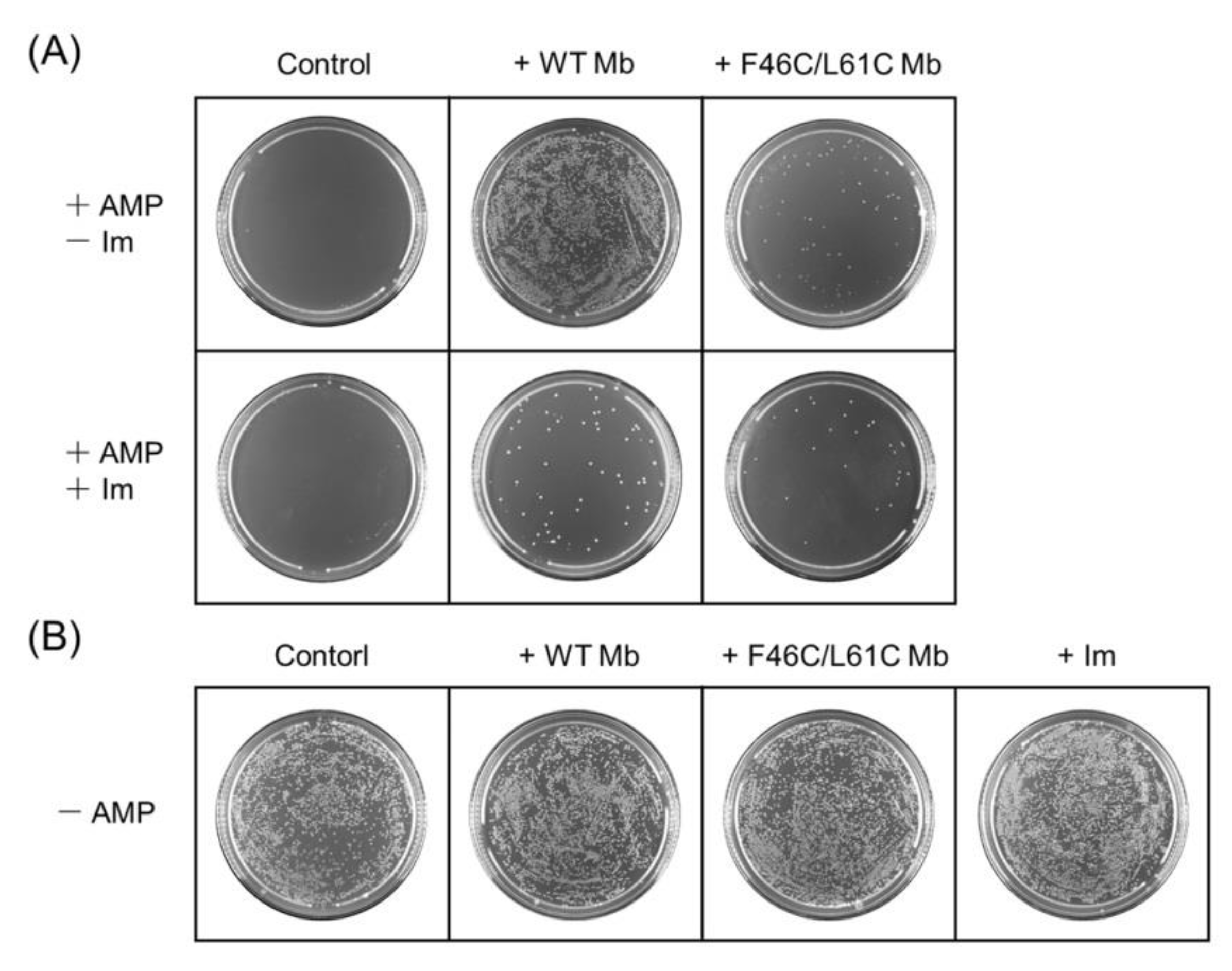
| Proteins | kcat (min−1) | kcat/KM (min−1 M−1) | Rate Enhancement kcat/kuncat * | Catalytic Proficiency (kcat/KM)/kuncat * |
|---|---|---|---|---|
| WT Mb | 404.38 ± 7.48 | 4.41 × 106 | 5.73 × 106 | 6.25 × 1010 |
| WT Mb + Im | 402.46 ± 32.89 | 2.04 × 106 | 5.70 × 106 | 2.89 × 1010 |
| F46C/L61C Mb | 141.27 ± 3.80 | 2.44 × 106 | 2.01 × 106 | 3.45 × 1010 |
| F46C/L61C Mb + Im | 95.49 ± 3.36 | 2.39 × 106 | 1.35 × 106 | 3.39 × 1010 |
Publisher’s Note: MDPI stays neutral with regard to jurisdictional claims in published maps and institutional affiliations. |
© 2022 by the authors. Licensee MDPI, Basel, Switzerland. This article is an open access article distributed under the terms and conditions of the Creative Commons Attribution (CC BY) license (https://creativecommons.org/licenses/by/4.0/).
Share and Cite
Tang, S.; Pan, A.-Q.; Wang, X.-J.; Gao, S.-Q.; Tan, X.-S.; Lin, Y.-W. O2 Carrier Myoglobin Also Exhibits β-Lactamase Activity That Is Regulated by the Heme Coordination State. Molecules 2022, 27, 8478. https://doi.org/10.3390/molecules27238478
Tang S, Pan A-Q, Wang X-J, Gao S-Q, Tan X-S, Lin Y-W. O2 Carrier Myoglobin Also Exhibits β-Lactamase Activity That Is Regulated by the Heme Coordination State. Molecules. 2022; 27(23):8478. https://doi.org/10.3390/molecules27238478
Chicago/Turabian StyleTang, Shuai, Ai-Qun Pan, Xiao-Juan Wang, Shu-Qin Gao, Xiang-Shi Tan, and Ying-Wu Lin. 2022. "O2 Carrier Myoglobin Also Exhibits β-Lactamase Activity That Is Regulated by the Heme Coordination State" Molecules 27, no. 23: 8478. https://doi.org/10.3390/molecules27238478
APA StyleTang, S., Pan, A.-Q., Wang, X.-J., Gao, S.-Q., Tan, X.-S., & Lin, Y.-W. (2022). O2 Carrier Myoglobin Also Exhibits β-Lactamase Activity That Is Regulated by the Heme Coordination State. Molecules, 27(23), 8478. https://doi.org/10.3390/molecules27238478






